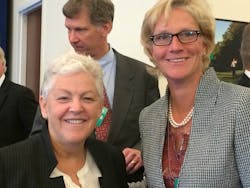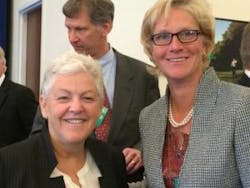Refrigerant Producers, Systems Manufacturers Meet at White House to Discuss Alternatives, Timetable
September 16, 2014 — A White House "Roundtable" discussion regarding the fate of hydrofluorocarbon refrigerants (HFCs) was held at the White House today. Among those present were representatives from DuPont, Johnson Controls, Honeywell, and Hillphoenix.
President Obama and his EPA team have a plan — a Climate Action Plan — to greatly reduce emissions from HFC refrigerants. The purpose of today's meeting was to obtain commitments and hear from refrigerant industry leaders on how they intend to support this ongoing mission.
According to the White House, emissions of high global-warming-potential HFCs are expected to nearly double from current levels of 1.5% of U.S. greenhouse gas emissions to 3% by 2020, and triple by 2030 if action is not taken.
Johnson Controls
“We applaud the Administration and the regulatory agencies for taking a collaborative approach with industry to manage the phase-down in use of HFCs,” said Laura Wand, vice president, chiller solutions, at Johnson Controls’ Building Efficiency business. “
At the event, Johnson Controls spoke up about the importance of considering the energy efficiency of the system when selecting a new refrigerant, not just its low global warming potential. Up to 98% of the total CO2 equivalent emissions over the life of air conditioning equipment can be due to energy use alone, not the global warming potential of the refrigerant contained. According to Wand, some new refrigerants being released on the global market can in fact lower equipment efficiency which will have a negative impact on the environment.
“The energy efficiency makes the greatest impact on the total carbon-footprint of a system over its life,” Wand said. “Therefore, when making choices on refrigerants, we cannot sacrifice energy efficiency.”
Contractor end-users will be pleased to know Johnson Controls has advocated for the interests of its customers during discussions with industry associations and legislators on the regulations and standards related to refrigerants. Similarly, sources say, the refrigerants that it chooses for its products will best fit the needs of its customers and the environment based on safety, energy efficiency, reliability, availability and cost.
The company has already spent more than $26 million over the past 3 years in the development of low global warming potential technologies.
DuPont was also represented at the Roundtable, with messages related to company history, the need to reduce emissions, and DuPont's solutions.
“DuPont welcomes the opportunity to participate in today’s White House Roundtable regarding hydrofluorocarbons (HFCs). DuPont has for almost 85 years been an innovator in refrigerants and insulating foam products, including HFCs, that have provided critical societal services such as refrigeration, air conditioning and energy efficiency while steadily improving the safety of these applications," said Kathryn K. McCord, global business director, DuPont Fluorochemicals.
“DuPont innovations have shown a steady reduction in impact to the ozone layer and climate, from CFCs to HCFCs, to HFCs and now to the new HFOs. DuPont also played a leading role in the development and implementation of the Montreal Protocol, the world’s most effective global environmental treaty. Under the Montreal Protocol the world has successfully addressed the threat of ozone depletion by phasing down the use of the previous generations of refrigerants, culminating in today’s generation of refrigerants, the non-ozone depleting HFCs," McCord continued.
“We recognize that HFCs can have high global warming potential and that without a change in direction, their use and emissions will increase substantially, particularly in the developing world. Innovation has led to the development of new substances that can replace HFCs to allow critical services to continue while greatly reducing greenhouse gas emissions.
“DuPont innovations have shown a steady reduction in impact to the ozone layer and climate, from CFCs to HCFCs, to HFCs and now to the new HFOs, McCord added. "DuPont also played a leading role in the development and implementation of the Montreal Protocol, the world’s most effective global environmental treaty. Under the Montreal Protocol the world has successfully addressed the threat of ozone depletion by phasing down the use of the previous generations of refrigerants, culminating in today’s generation of refrigerants, the non-ozone depleting HFCs."
For cars, DuPont's HFO-1234yf (Opteon YF) has a global warming potential (GWP) that's 99.9% lower than R-134a.
DuPont reports its new Opteon XP40 is showing similar efficiency gains in commercial refrigeration, significantly reducing power consumption and related carbon dioxide (CO2) emissions, and a new refrigerant under development is showing substantial promise in improving industrial energy efficiency by capturing and recycling waste heat.
Hillphoenix
Hillphoenix President/CEO Paul Sidoni also attended the meeting, which was organized by the Council on Environmental Quality.
In 1995, the company introduced one of the industry’s first emissions-reducing coolant technologies. Since then, it has been a leader in moving sustainable refrigeration technologies to the market, and helping supermarkets keep pace with regulatory changes. Hillphoenix’s environmental improvements in alternative refrigerants and energy efficiency have removed more than 2 billion pounds of harmful emissions from the atmosphere since the mid-1990s.
Recently, Hillphoenix, in partnership with Sprouts Farmers Market, unveiled a refrigeration system that eliminates the use of harmful HFCs even in warm climates. In addition, the company’s Close the Case initiative, which puts energy-saving doors on open refrigerated display cases, has helped grocers cut case energy consumption by 70%.
Honeywell
Sources for Honeywell announced during the meeting that it will increase production of its low-global-warming-potential (GWP) refrigerants, insulation materials, aerosols and solvents, and, prior to 2020, will drive a 50% reduction in its annual production of high-GWP hydrofluorocarbons (HFCs) on a CO2 equivalent basis.
Honeywell has already reduced its CO2-equivalent fluorocarbon production by 30% since 2007 by converting legacy production assets to low-global-warming technologies. The company plans to reduce CO2-equivalent production of HFCs by an additional 50% over the next five years as customers throughout the world adopt new LGWP products to reduce greenhouse gas emissions, increase energy efficiency and meet proposed tighter U.S. Environmental Protection Agency (EPA) regulations.
“Regulators around the world are taking steps to address climate change, and Honeywell is an industry leader in this area with technologies that significantly reduce greenhouse gas emissions and an array of technologies that promote energy efficiency and cleaner energy production,” said Darius Adamczyk, president and chief executive officer of Honeywell Performance Materials and Technologies.

